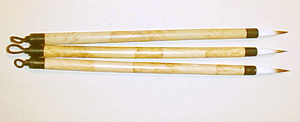 |
|
The Four Treasures of the
Study
|
The four
stationery items indispensable to any traditional
Chinese scholar are a brush pen, an inkstick, paper, and
an inkstone. They are the main tools with which he
carries out his scholarly work, and for this reason they
came to be called the "four treasures of the study" (wen
fang szu pao).

The distinctive and elegant arts of
Chinese calligraphy and painting have in recent years taken a prominent place in
the international art world, and are the focus of much interest and discussion.
Any person involved in the traditional Chinese arts of painting and calligraphy
must rely heavily on the brush pen, ink, paper, and the
inkstone, for it is only through these tools that the beauty of Chinese art receives concrete expression. As a result,
much importance has been attached the "four treasures of the study."
tools that the beauty of Chinese art receives concrete expression. As a result,
much importance has been attached the "four treasures of the study."
"To do a good job, one must first sharpen
one's tools," a Chinese aphorism goes. An artist naturally takes selection of
his tools very seriously. In dynasties of literary prominence, such as the T'ang
(618-907 A.D.) and Sung (960-1279 A.D.), the art of the "four treasures of the
study" reached heights of exquisiteness and excellence. Examples are the T'ang
dynasty Chu Ke brush pen and Tuan Hsi inkstone, and the Li T'ing-Kuei inkstick
and Ch'eng Hsin T'ang paper of the Five Dynasties period (907-960 A.D.). High
quality "treasures of the study" made a direct contribution to the development
of Chinese painting and calligraphy. The popularization of printing and mass
production of paper and ink in the Sung dynasty permitted the works of the many
outstanding calligraphers and painters who emerged at that time to be widely
distributed. Many books published in these early times are still extant today;
the fact that the paper remained intact and the ink did not fade away after more
than one thousand years is proof of the high quality of workmanship employed.

Much is being done in the Taiwan to not
only preserve traditional Chinese culture, but also continually introduce
innovations and improvements. While retaining the merits and strengths of the
traditional "four treasures of the study," modern technology and materials are
being applied to make these "treasures" even more practical and suited to the
needs of the user. The dependence of the Chinese arts of calligraphy and
painting on this set of traditional "treasures of the study" to express the
thoughts, writing system, life experience, and feelings of the Chinese people
has brought forth an eternal, unfading cultural institution.
|
 |

